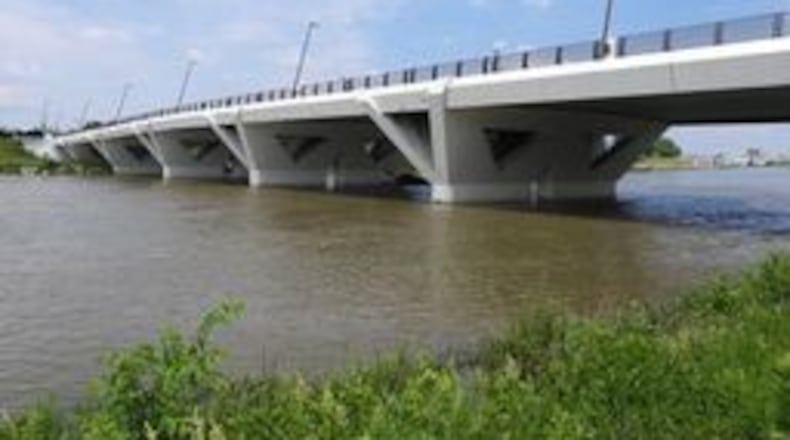In the last 18 years, 18 bridges were rebuilt over Dayton’s rivers.
The people behind the effort created gathering places. They revived Dayton’s legacy of placemaking. They colored the nighttime skyline. And, they managed to have other agencies pay more than 91% of the cost.
In 1999, Steve Finke, Dayton’s city engineer and assistant public works director, knew the city’s bridges needed to be replaced.
The structures ranged in age from 72 to 93 years in 1999.
Finke knew the city didn’t have enough money to pay for new bridges.
By 2002, Finke persuaded ODOT director Gordon Proctor to create the Local Major Bridge Program. Dayton received its first award for $2.5 million for the Findlay Street bridge in 2003. Finke then secured $5.3 million to replace the Washington Street bridge. By 2008, the city had $12.3 million of ODOT funds for Stewart Street.
“We had great partners at ODOT,” said Finke.
ODOT’s support motivated city leaders to commit funds. “They didn’t want to turn down 92% share,” Finke said.
The 100-year-old concrete arch Washington Street Bridge replacement energized John Gower, Dayton’s director of planning. Dayton’s Woolpert engineering firm created arch-like features along the length of the structure with decorative keystones, perforated parapet walls and lighting accents.
Gower saw the art form in bridge building. On remaining bridge projects, he gave architectural concepts to the design team so each connected with the community uniquely.
Gower fell in love with Dayton in high school in the Dayton View neighborhood. He studied architecture at the University of Cincinnati. After a couple of internships, he accepted an offer to work in Dayton’s Planning Department, where he worked for 32 years .
The next big bridge was Stewart Street. Finke and Gower knew they could make every bridge unique. Finke wanted the city to have beautiful bridges, not “ODOT ugly” ones. Each bridge includes wide sidewalks, plazas and pedestrian-friendly lighting. Highly visible bridges have color-changing lights.
Stewart Street’s bridge includes inverted triangular supports illuminated by color-changing LED lights that can dance like fireworks or provide a serene landscape.
National media highlighted the bridge during First Four games. Citizens requested colors for special events. UD wanted team colors on game days. Stewart Street’s lights cost less than 1% of the project.
“The Stewart Street bridge was a huge success,” said Joe Weinel, Dayton’s chief engineer of the Design Bureau.
Cities from around the country asked about copying the bridge.
Finke and Gower visualized the future, and Weinel and Keith Steeber muscled through the details of construction drawings, contracts and inspections. Steeber retired in 2020 as city engineer after a 36-year career.
Weinel’s favorite bridge is Webster Street. Its industrial design has oversized pylons on each corner, gathering places and sidewalks. The plaques that line the plazas on the west side of the bridge narrate the city’s bridge history.
Webster Street was the first bridge built after the 1913 flood at a cost of $113,000. It was replaced after 101 years at a cost of nearly $11 million.
Weinel and Steeber were involved with every project since the first one at Findlay Street.
Dayton taxpayers paid $11.5 million of the total cost, less than 8.5% of the $133 million total cost of all 18 bridges.
Local architects copied lighting techniques used on the bridges. Greater Dayton RTA, Care Source and the Montgomery County Administration Building added color-changing lights to add emphasis.
Gower said: “In the 1960s, Dayton got smarter about what was being built in the city. This led to Courthouse Square, Arcade Square and the Fifth Street District. All created play spaces, based on the interaction of people with buildings.”
Using the same concept, Dayton created play spaces where people interact with bridges. Each bridge makes a unique connection to the community.
Next time you’re downtown, join others as they wait for the sun to set and the lights to shine on the bridges of Dayton.
Julia Gourley is a member of the Dayton Journalism Lab and a professional engineer with 29 years of experience in public infrastructure departments.
About the Author








